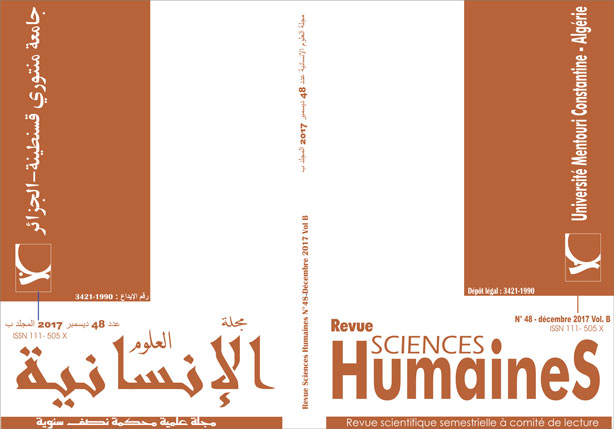Raising Teachers’ Awareness of the Significance of Formulaic Sequences in Writing Proficiency
Keywords:
formulaic sequences, writing proficiency, awareness-raising, EFL teachers, attitudesAbstract
In recent years, the academic arena witnessed a renewed interest in the role of vocabulary and with it the phenomenon of formulaic sequences (these are multi-word units which are stored and retrieved as whole from memory) came to the fore. Much research proved that these sequences are closely related to writing proficiency. In fact, several studies were carried out to investigate the use of formulaic sequences by language learners; however, investigating these sequences from the perspective of teachers was largely unexplored. Therefore, the present study attempted to explore English as a foreign Language (EFL) teachers’ awareness of the formulaicity of language, their attitudes as well as practices regarding the incorporation of these sequences in writing classrooms. To achieve this purpose, a questionnaire was administered to 12 teachers of Written Expression at the department of English at Larbi Ben M’hidi University of Oum El Bouaghi. The obtained results showed the teachers’ lack of awareness of the formulaicity of language. The study also revealed that though the teachers found formulaic sequences of high importance in improving writing proficiency and showed positive attitudes towards their inclusion in their writing classrooms, the instruction of these sequences was not really part of their teaching agenda.
Downloads
References
Boers, F., Eyckman, J. Kappel, J. Stenger, H., &Demecheleer. (2006). Formulaic sequences and perceived oral proficiency : Putting a lexical approach to the test. Language Teaching Research, 10 (3), 245-261. doi: 10. 1191/1362168806lr195oa
Boers, F., &Lindstromberg, S. (2009). Optimizing a lexical approach to instructed second-language acquisition. London, England: Macmillan.
Bolander, M. (1989). Prefabs, patterns and rules in interaction? Formulaic speech in adult learners’ L2 Swedish. In K. Hyltenstan& L. K. Obler (Eds.), Bilingualism across the lifespan: Aspects of acquisition, maturity, and loss (pp. 73-86). Cambridge, NY: Cambridge University Press.
Chomsky, N. (1965). Aspects of the theory of syntax. Cambridge, MA: M. I. T. Press.
Čolović-Marković, J. (2012). The effects of explicit instruction of formulaic sequences on second-language writers (Unpublished doctoral dissertation). The niversity of Utah, The United States.
Cortes, V. (2004). Lexical bundles in published and student disciplinary writing: Examples from history and biology. English for Specific Purposes, 23, 397-423. doi: 10.1016/j.esp.2003.12.001.
Cowie, A. P. ( 1992). Multiword lexical units and communicative language teaching. In P. J. L. Arnaud & H. Béjoint (Eds.), Vocabulary and applied linguistics (pp.1-12). London, England: Macmillan.
Coxhead, A. & Byrd, P. (2007). Preparing writing teachers to teach the vocabulary and grammar of academic prose. Journal of Second Language Writing, 16, 129-147. doi: 10.1016/j.jslw.2007.07.002.
Dai, Z. & Ding, Y. (2010). Effectiveness of text memorization in EFL learning of Chinese students. In D. Wood (Ed.), Perspectives on formulaic language: Acquisition and communication (pp. 71- 87). London, England: Continuum.
Erman, B. & Warren, B. (2000). The idiom principle and the open choice principle. Text, 20 (1), 29-62.
Foster, P. (2001). Rules and routines: A consideration of their role in the task based language production of native and non-native speakers. In M. Bygates, P. Skehan, & M. Swain (Eds.), Researching pedagogic tasks: Second language learning, teaching and testing (pp. 75-93). Harlow, England: Pearson.
Granger, S. (1998). Prefabricated patterns in advanced EFL writing: Collocations and formulae. In A. P. Cowie (Ed.), Phraseology: Theory, analysis, and applications (145-160). Oxford, NY: Oxford University Press.
Jones, M. & Haywood, S. (2004). Facilitating the Acquisition of formulaic sequences: An exploratory study in an EAP context. In N. Schmitt (Ed.), Formulaic sequences: Acquisition, processing and use (pp. 269-292). Amsterdam, The Netherlands: Benjamins.
Lewis, M. (1993). Thelexical approach: The state of ELT and a way forward. Hove, England: Language Teaching Publications.
Lewis, M. (1997). Pedagogical implications of the lexical approach. In J. Coady& T. Huckin (Eds.), Second language vocabulary acquisition: A rationale for pedagogy (pp. 255-270). Cambridge, England: Cambridge University Press.
Lewis, M. (Ed.). (2000). Teaching collocations: Further developments in the lexical approach. Hove, England: Language Teaching Publications.
Nattinger, J. R. &DeCarrico, J. S. (1992). Lexical phrases and language teaching. Oxford, England: Oxford University Press.
Ohlrogge, A. (2009). Formulaic expressions in intermediate EFL writing assessment. In R. Corrigan, E. A. Moravcsik, H. Ouali, & K. M. Wheatley (Eds.), Formulaic language: Acquisition, loss, psychological reality, and functional explanations (Vol. 2, pp. 375-386). Amsterdam, The Netherlands: Benjamins.
Pawley, A., &Syder, F. (1983). Two puzzles for linguistic theory: Native-like selection and native-like fluency. In J. Richards, & R. Schmidt ( Eds.), Language and communication (pp. 191-226). London, England: Longman.
Schmitt, N. (Ed.) (2004). Formulaic sequences: Acquisition, processing and use. Amsterdam, The Netherlands: Benjamins.
Schmitt, N. & Carter, R. (2004). Formulaic sequences in action: An introduction. In N. Schmitt (Ed.), Formulaic sequences: Acquisition, processing and use (pp.1-22). Amsterdam, The Netherlands: Benjamins.
Wei, L. & Ying, H. (2011). On the role of formulaic sequences in second language acquisition. US-China Foreign Language, 9 (11), 708-713.
Widdowson, H. G. (1989). Knowledge of language and ability for use. Applied Linguistics, 10 (2), 128- 137.
Wood, D. (2002). Formulaic Language in Acquisition and Production: Implications for teaching. TESL Canada Journal, 20 (1), 1-15.
Wood, D. (2010). Formulaic Language and second language speech fluency: Background, evidence and classrooms applications. London, England: Continuum.
Wray, A. (2002). Formulaic language and the lexicon. Cambridge, England: Cambridge University Press.
















